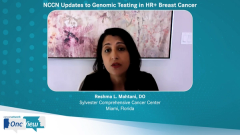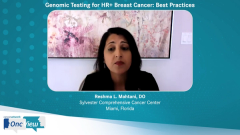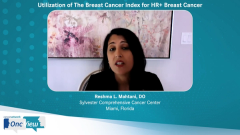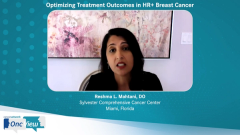
Adjuvant Vs Extended Adjuvant Therapy in HR+ Breast Cancer
The goals of adjuvant therapy versus extended adjuvant therapy for early-stage HR+ breast cancer and current treatment options available for each approach.
Episodes in this series

Kristie Kahl: Welcome to CancerNetwork®’s OncView program titled “Individualizing Extended Adjuvant Therapy in HR+ Breast Cancer.” Our discussion is going to focus on adjuvant therapy in hormone receptor–positive breast cancer. Welcome. Let’s begin. Dr Gadi, what’s the difference between adjuvant and extended adjuvant therapy in patients with early stage hormone receptor–positive breast cancer?
Vijayakrishna Gadi, MD, PhD: Before I start answering that question, I want to make 1 disclosure. I’ve spent my career focused, to some degree, on diagnostics development. I’m a founder of a company called SEngine Precision Medicine. I have intellectual property in a company called Chimerasite, I have received research funding from Agendia, and I served as a consultant speaker for Hologic.
In regard to the differences between adjuvant therapy and extended adjuvant therapy in breast cancer, we have multiple types of breast cancer. With regard to hormone-positive breast cancer in particular, many of us intuitively have known, based on our clinical practice, that these are patients who have a long horizon for being at risk for a recurrence. These recurrences can happen quickly—a few years after the initial therapy—but we know there’s a long tail, so there are folks who can recur as many as 10, 15, 20, 25 years later. Because of that, we are developing segments of time in which to think about these patients. In the early stage setting and soon after, the first 5 years, we call the adjuvant setting. Then there is this component of time we are terming extended adjuvant setting in hormone-positive disease, which extends from that fifth year and beyond.
Kristie Kahl: What is the goal of each type of treatment?
Vijayakrishna Gadi, MD, PhD: In the early stage treatment, when we think about cancers in the first 5 years, we’re worried about cancers that are oftentimes highly proliferative, having features that would predict an early recurrence. The idea is using a combination of multiple types of therapies. But in terms of the systemic therapies—focused on antiestrogen therapies, chemotherapy, and novel biologics in the context of HER2 [human epidermal growth factor receptor 2]–positive disease—the goal of all those therapies is to say that at the end of 5 years after the initial diagnosis, the patient is free of disease. Those are the tools we typically try to look at in that immediate 5 years. As an extension in the extended phase of things, these are cancers that probably have been hibernating and lurking in this stage. Whatever molecular programs take place to turn them on again after that fifth year, we ask, “What are the tools we might have available to prevent that from happening for these slumbering cancer cells?” The main focus has been looking and focusing on endocrine therapies, antiestrogen-type medicines for that fifth year and beyond.
Kristie Kahl: You just mentioned the endocrine therapies. What are the current treatment options for both treatment types?
Vijayakrishna Gadi, MD, PhD: In the early stage setting, the primary methods we use are either estrogen receptor blockade, or aromatase inhibition. In terms of estrogen receptor blockade, the drug we primarily use in this country is tamoxifen, which binds to the estrogen receptor and prevents the estrogen receptor from landing on its typical sites within the nucleus of the cancer cell and promoting growth to the cancer cell. With the aromatase inhibitors, we block that enzyme. By doing so, we block the terminal step of turning pre-estrogens into active estrogens. When we do this in the peripheral tissues, it makes it really difficult for cancer cells to survive in these other organs. As a result, they die over time. Those are the 2 mechanisms we focus on. Both can be used in the first 5 years. Certainly, in premenopausal women, we don’t use the aromatase inhibitors because there can be certain toxicities and there may also be diminished benefit of those medicines. To make them feasible in that premenopausal patient population, we combine those aromatase inhibitors with drugs that suppress the ovarian function. When we combine the 2 together, they work quite well in terms of preventing recurrences from happening, especially in high risk, early stage cancers in young women.
Transcript edited for clarity.
Newsletter
Stay up to date on recent advances in the multidisciplinary approach to cancer.
























































































